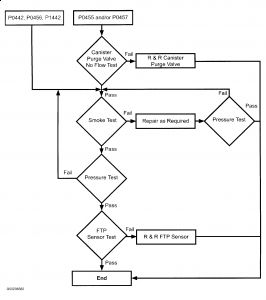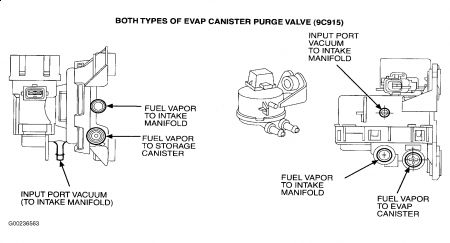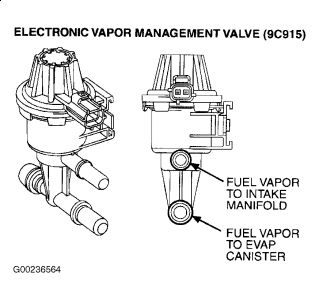Engine stalls on road: Once the engine runs for one second, PATS CANNOT disable the engine. Running stalls are not PATS related issues
Check and suspect IAC valve
MIL WITH DTC'S P0442, P0455, P0456, P0457, P1442 OR CHECK FUEL CAP LAMP WITH DTC P0457
TECHNICAL SERVICE BULLETIN
Reference Number(s): 03-20-3, Date of Issue: October 13, 2003
Superceded Bulletin(s): 03-9-8, Date of Issue: May 12, 2003
Related Ref Number(s): 01-7-8, 03-20-3, 03-9-8
ARTICLE BEGINNING
DESCRIPTION
DRIVEABILITY - MALFUNCTION INDICATOR LAMP (MIL) ILLUMINATED WITH DTC'S P0442, P0455, P0456, P0457, P1442 OR CHECK FUEL CAP LAMP ILLUMINATED WITH DTC P0457
ISSUE
NOTE:This article supersedes TSB 03-9-8 to update the vehicle lines and Service Procedures.
Some vehicles may exhibit a Malfunction Indicator Lamp (MIL) illuminated with Diagnostic Trouble Codes (DTCs) P0442, P0455, P0456, P0457 or P1442 or a "Check Fuel Cap" Lamp illuminated with DTC P0457 for the Evaporative Emission System. This may be caused by loose or leaking hoses, loose or broken fuel cap, a leak at the top of the fuel filler pipe neck, etc.
ACTION
Use the Rotunda Leak Detector Smoke Machine (Part 218-00001) or equivalent, to locate and repair leaks in the Evaporative Emission System. Refer to the following Service Procedure for details.
Definitions of Acronyms
CVS Canister Vent Solenoid
DTC Diagnostic Trouble Code
EVAP Evaporative Emissions System
EVMV Electronic Vapor Management Valve
FTP Fuel Tank Pressure
MIL Malfunction Indicator Lamp
NGS New Generation STAR Tester
PID Parameter Identifier
WDS Worldwide Diagnostic System
SERVICE PROCEDURE
NOTE:THIS PROCEDURE SUPERSEDES ALL OTHER PROCEDURES PUBLISHED IN SERVICE MANUALS AND TSB ARTICLES.
NOTE:MANY EVAP LEAKS ARE CAUSED BY A LOOSE OR FAULTY CAP. IF THE FUEL CAP IS SUSPECT DURING VISUAL INSPECTION, DO NOT DISTURB THE FUEL CAP UNTIL THE DIAGNOSTIC PROCEDURE IS COMPLETE. IF THE LEAK VERIFICATION FAILS, THE CAP CAN BE REPOSITIONED OR REPLACED AND THE TEST REPEATED. THIS ACTION WILL ISOLATE THE CAP FROM THE REST OF THE EVAP SYSTEM AS A POTENTIAL CONCERN. IF DEBRIS ON THE SEALING SURFACE OF THE CAP APPEARS TO BE THE SOURCE OF THE LEAK, CLEAN THE CAP AND REINSTALL.
OVERVIEW OF TEST PROCEDURES
NOTE:SEE (Fig. 1 ) AT END OF ARTICLE FOR TEST PROCEDURE FLOWCHART.
This TSB provides the following procedures:
Check the EVAP Canister Purge Valve (9C915) for a no flow condition
Locate a leak so that a repair can be performed
Verify repair by utilizing a metered air pressure test
EVAP CANISTER PURGE VALVE NO FLOW TEST
Using WDS Datalogger select the following PID's: EVAPVM# (or EVMV#), EVAPCV# and FTP.
Start the vehicle.
Close both the Canister Vent Solenoid (CVS) (EVAPCV# On or 100% duty cycle) and the EVAP Canister Purge Valve (EVAPVM# Off or zero % duty cycle).
While monitoring the FTP PID, command open the EVAP Canister Purge Valve with the EVAPVM# PID to 100% duty.
If the FTP decreases and/or the RPM changes and/or the engine stalls, the test passed. Turn off engine and proceed to test procedures below. Otherwise replace the EVAP Canister Purge Valve, verify the repair by repeating the No Flow Test and return vehicle.
SYSTEM LEAK CHECK (SMOKE TEST PROCEDURE)
Disconnect the larger of two manifold vacuum lines at the EVAP Canister Purge Valve and cap it at the EVAP Canister Purge Valve (see Fig. 2 ).
Connect the Smoke Machine power cables to vehicle battery. The "Power Indicator Lamp" should be on indicating a good battery contact.
Position the selector valve on Rotunda's Smoke Machine Control Panel to "SMOKE".
Locate the vehicle's Evaporative Emission Service Test Port and remove the green cap. The EVAP Service Test Port is located close to or on the EVAP Canister Purge Valve.
WARNING:DO NOT REMOVE THE SCHRADER VALVE. REMOVING THE SCHRADER VALVE FROM THE TEST PORT ON VEHICLES EQUIPPED WITH THE ELECTRONIC VAPOR MANAGEMENT VALVE (9G641) AND/OR ELECTRONIC VAPOR MANAGEMENT VALVE & BRACKET ASSEMBLY (9G683) (SEE Fig. 3 ), OR EVAP CANISTER PURGE VALVE (9C915) AND/OR EVAP CANISTER PURGE VALVE & BRACKET ASSEMBLY (9F933) (SEE Fig. 2 ) WILL PERMANENTLY DAMAGE THE VALVE.
Install the EVAP Emission Test Port Adapter that is provided with the Rotunda's Smoke Machine to EVAP Canister Purge Valve test port.
SPECIAL PROCEDURES HAVE BEEN DESIGNATED FOR WINDSTAR, LS, THUNDERBIRD & PZEV FOCUS BECAUSE THEY HAVE A CHECK VALVE THAT WILL PREVENT SMOKE FROM ENTERING THE FILLER NECK.
Connect black smoke hose nozzle tip to the EVAP Emission Test Port Adapter. For all except Windstar, LS, Thunderbird & PZEV Focus - Use NGS or WDS to close CVS. (CVS WILL REOPEN AFTER NINE (9) MINUTES OF CONTINUOUS OPERATION).
For all except Windstar, LS, Thunderbird & PZEV Focus - Remove the fuel cap from the vehicle. Depress remote starter button: Smoke will be introduced into the EVAP Emission System. Secure the fuel cap once smoke is seen exiting from the fuel tank's neck area. For Windstar, LS, Thunderbird & PZEV Focus, do not remove fuel cap. Depress starter button and introduce smoke to system until it can be seen exiting the CVS (located by filler neck). Once smoke is seen, use NGS or WDS to close CVS. (CVS WILL REOPEN AFTER NINE (9) MINUTES OF CONTINUOUS OPERATION).
Press and release the remote starter button in intervals of approximately 15 seconds on and 15 seconds off. Use the halogen light provided with the Smoke Machine to look for smoke in the engine compartment, EVAP hoses to EVAP Canister Purge Valve, CVS, carbon canister and area around the fuel cap. Wiggle fuel vapor lines to check for leaks. Check for leaks in areas that are difficult to access, such as connections on top of the tank where connections may be or inside frame rails. Use the black light to ensure that there are no leaks. If a leak is detected, repair as necessary. If the leak is not detected from the top, check under the bottom of vehicle. Inspect the EVAP hoses running to the carbon canister, fuel filler neck, CVS, and EVAP Canister Purge Valve. Go to LEAK VERIFICATION to verify any repair or if no leak is found.
LEAK VERIFICATION (METERED AIR SYSTEM)
Position the selector valve located on the Smoke Machine control panel to "METER".
Verify calibration of the flow meter by using the .020" calibrated leak orifice. To do this, insert air supply hose (transparent hose) nozzle tip into appropriate EVAP System calibrated leak orifice located on the front of the Smoke Machine panel.
TURN ON: Depress the remote starter button. Observe the position of the flow meter indicator ball. Position the flow meter red pointer flag so it aligns with the measurement of the indicator ball. Release the button and remove the air supply hose nozzle tip from the EVAP System calibrated leak orifice.
NOTE:THIS FLOW METER CALIBRATION MEASUREMENT INDICATES THE VEHICLE PASS OR FAIL CRITERIA BASED ON THE .020" EVAP SYSTEM LEAK STANDARD.
Connect the transparent air supply hose nozzle tip into the EVAP Service Test Port adapter.
Use NGS or WDS Diagnostic tool to CLOSE the CVS.
Depress the remote starter button on the Rotunda's Smoke Leak Detector. The indicator ball in the flowmeter will go all the way to the top indicating the system is being pressurized. Continue to depress the remote starter button until the ball stops descending. Once the indicator ball has stopped descending, observe if it is above or below the red indicator flag. If performing this verification following a repair, go to Step 7. If performing this verification after performing the SYSTEM LEAK CHECK (SMOKE TEST PROCEDURE), go to Step 8.
Leak Verification After Repair
If the measurement is below the indicator flag the system has passed. The test procedure is complete. Remove the Smoke Machine Test equipment from the vehicle and reconnect the large EVAP Canister Purge Valve manifold vacuum hose and the test port's green cap.
If the measurement is above the indicator flag, repeat SYSTEM LEAK CHECK (SMOKE TEST PROCEDURE).
Leak Verification After Passing SYSTEM LEAK CHECK (SMOKE TEST PROCEDURE)
If the measurement is below the indicator flag the system has passed, go to Step 9.
If the measurement is above the indicator flag, repeat SYSTEM LEAK CHECK (SMOKE TEST PROCEDURE).
Using WDS Datalogger or NGS select the FTPV PID.
Remove Fuel Cap and turn the vehicle's ignition switch to the run position and check the FTPV PID.
The nominal value for the FTPV PID is 2.6V. If the value is greater than 2.8V or less than 2.4V, the FTP sensor is out of range and should be replaced. Verify the repair by checking to see if the new sensor is in range. For all except Windstar, LS, Thunderbird & PZEV Focus - if the sensor is within range, the concern is no longer present. (Windstar, LS, Thunderbird & PZEV Focus go to Step 12.)
For Windstar, LS, Thunderbird & PZEV Focus only verify that filler neck clamps are in good working order and tightened. Repair as necessary. If no problem is found with clamps, replace the fuel cap
MIL WITH DTC'S P0442, P0455, P0456, P0457, P1442 OR CHECK FUEL CAP LAMP WITH DTC P0457
TECHNICAL SERVICE BULLETIN
Reference Number(s): 03-20-3, Date of Issue: October 13, 2003
Superceded Bulletin(s): 03-9-8, Date of Issue: May 12, 2003
Related Ref Number(s): 01-7-8, 03-20-3, 03-9-8
ARTICLE BEGINNING
DESCRIPTION
DRIVEABILITY - MALFUNCTION INDICATOR LAMP (MIL) ILLUMINATED WITH DTC'S P0442, P0455, P0456, P0457, P1442 OR CHECK FUEL CAP LAMP ILLUMINATED WITH DTC P0457
ISSUE
NOTE:This article supersedes TSB 03-9-8 to update the vehicle lines and Service Procedures.
Some vehicles may exhibit a Malfunction Indicator Lamp (MIL) illuminated with Diagnostic Trouble Codes (DTCs) P0442, P0455, P0456, P0457 or P1442 or a "Check Fuel Cap" Lamp illuminated with DTC P0457 for the Evaporative Emission System. This may be caused by loose or leaking hoses, loose or broken fuel cap, a leak at the top of the fuel filler pipe neck, etc.
ACTION
Use the Rotunda Leak Detector Smoke Machine (Part 218-00001) or equivalent, to locate and repair leaks in the Evaporative Emission System. Refer to the following Service Procedure for details.
Definitions of Acronyms
CVS Canister Vent Solenoid
DTC Diagnostic Trouble Code
EVAP Evaporative Emissions System
EVMV Electronic Vapor Management Valve
FTP Fuel Tank Pressure
MIL Malfunction Indicator Lamp
NGS New Generation STAR Tester
PID Parameter Identifier
WDS Worldwide Diagnostic System
SERVICE PROCEDURE
NOTE:THIS PROCEDURE SUPERSEDES ALL OTHER PROCEDURES PUBLISHED IN SERVICE MANUALS AND TSB ARTICLES.
NOTE:MANY EVAP LEAKS ARE CAUSED BY A LOOSE OR FAULTY CAP. IF THE FUEL CAP IS SUSPECT DURING VISUAL INSPECTION, DO NOT DISTURB THE FUEL CAP UNTIL THE DIAGNOSTIC PROCEDURE IS COMPLETE. IF THE LEAK VERIFICATION FAILS, THE CAP CAN BE REPOSITIONED OR REPLACED AND THE TEST REPEATED. THIS ACTION WILL ISOLATE THE CAP FROM THE REST OF THE EVAP SYSTEM AS A POTENTIAL CONCERN. IF DEBRIS ON THE SEALING SURFACE OF THE CAP APPEARS TO BE THE SOURCE OF THE LEAK, CLEAN THE CAP AND REINSTALL.
OVERVIEW OF TEST PROCEDURES
NOTE:SEE (Fig. 1 ) AT END OF ARTICLE FOR TEST PROCEDURE FLOWCHART.
This TSB provides the following procedures:
Check the EVAP Canister Purge Valve (9C915) for a no flow condition
Locate a leak so that a repair can be performed
Verify repair by utilizing a metered air pressure test
EVAP CANISTER PURGE VALVE NO FLOW TEST
Using WDS Datalogger select the following PID's: EVAPVM# (or EVMV#), EVAPCV# and FTP.
Start the vehicle.
Close both the Canister Vent Solenoid (CVS) (EVAPCV# On or 100% duty cycle) and the EVAP Canister Purge Valve (EVAPVM# Off or zero % duty cycle).
While monitoring the FTP PID, command open the EVAP Canister Purge Valve with the EVAPVM# PID to 100% duty.
If the FTP decreases and/or the RPM changes and/or the engine stalls, the test passed. Turn off engine and proceed to test procedures below. Otherwise replace the EVAP Canister Purge Valve, verify the repair by repeating the No Flow Test and return vehicle.
SYSTEM LEAK CHECK (SMOKE TEST PROCEDURE)
Disconnect the larger of two manifold vacuum lines at the EVAP Canister Purge Valve and cap it at the EVAP Canister Purge Valve (see Fig. 2 ).
Connect the Smoke Machine power cables to vehicle battery. The "Power Indicator Lamp" should be on indicating a good battery contact.
Position the selector valve on Rotunda's Smoke Machine Control Panel to "SMOKE".
Locate the vehicle's Evaporative Emission Service Test Port and remove the green cap. The EVAP Service Test Port is located close to or on the EVAP Canister Purge Valve.
WARNING:DO NOT REMOVE THE SCHRADER VALVE. REMOVING THE SCHRADER VALVE FROM THE TEST PORT ON VEHICLES EQUIPPED WITH THE ELECTRONIC VAPOR MANAGEMENT VALVE (9G641) AND/OR ELECTRONIC VAPOR MANAGEMENT VALVE & BRACKET ASSEMBLY (9G683) (SEE Fig. 3 ), OR EVAP CANISTER PURGE VALVE (9C915) AND/OR EVAP CANISTER PURGE VALVE & BRACKET ASSEMBLY (9F933) (SEE Fig. 2 ) WILL PERMANENTLY DAMAGE THE VALVE.
Install the EVAP Emission Test Port Adapter that is provided with the Rotunda's Smoke Machine to EVAP Canister Purge Valve test port.
SPECIAL PROCEDURES HAVE BEEN DESIGNATED FOR WINDSTAR, LS, THUNDERBIRD & PZEV FOCUS BECAUSE THEY HAVE A CHECK VALVE THAT WILL PREVENT SMOKE FROM ENTERING THE FILLER NECK.
Connect black smoke hose nozzle tip to the EVAP Emission Test Port Adapter. For all except Windstar, LS, Thunderbird & PZEV Focus - Use NGS or WDS to close CVS. (CVS WILL REOPEN AFTER NINE (9) MINUTES OF CONTINUOUS OPERATION).
For all except Windstar, LS, Thunderbird & PZEV Focus - Remove the fuel cap from the vehicle. Depress remote starter button: Smoke will be introduced into the EVAP Emission System. Secure the fuel cap once smoke is seen exiting from the fuel tank's neck area. For Windstar, LS, Thunderbird & PZEV Focus, do not remove fuel cap. Depress starter button and introduce smoke to system until it can be seen exiting the CVS (located by filler neck). Once smoke is seen, use NGS or WDS to close CVS. (CVS WILL REOPEN AFTER NINE (9) MINUTES OF CONTINUOUS OPERATION).
Press and release the remote starter button in intervals of approximately 15 seconds on and 15 seconds off. Use the halogen light provided with the Smoke Machine to look for smoke in the engine compartment, EVAP hoses to EVAP Canister Purge Valve, CVS, carbon canister and area around the fuel cap. Wiggle fuel vapor lines to check for leaks. Check for leaks in areas that are difficult to access, such as connections on top of the tank where connections may be or inside frame rails. Use the black light to ensure that there are no leaks. If a leak is detected, repair as necessary. If the leak is not detected from the top, check under the bottom of vehicle. Inspect the EVAP hoses running to the carbon canister, fuel filler neck, CVS, and EVAP Canister Purge Valve. Go to LEAK VERIFICATION to verify any repair or if no leak is found.
LEAK VERIFICATION (METERED AIR SYSTEM)
Position the selector valve located on the Smoke Machine control panel to "METER".
Verify calibration of the flow meter by using the .020" calibrated leak orifice. To do this, insert air supply hose (transparent hose) nozzle tip into appropriate EVAP System calibrated leak orifice located on the front of the Smoke Machine panel.
TURN ON: Depress the remote starter button. Observe the position of the flow meter indicator ball. Position the flow meter red pointer flag so it aligns with the measurement of the indicator ball. Release the button and remove the air supply hose nozzle tip from the EVAP System calibrated leak orifice.
NOTE:THIS FLOW METER CALIBRATION MEASUREMENT INDICATES THE VEHICLE PASS OR FAIL CRITERIA BASED ON THE .020" EVAP SYSTEM LEAK STANDARD.
Connect the transparent air supply hose nozzle tip into the EVAP Service Test Port adapter.
Use NGS or WDS Diagnostic tool to CLOSE the CVS.
Depress the remote starter button on the Rotunda's Smoke Leak Detector. The indicator ball in the flowmeter will go all the way to the top indicating the system is being pressurized. Continue to depress the remote starter button until the ball stops descending. Once the indicator ball has stopped descending, observe if it is above or below the red indicator flag. If performing this verification following a repair, go to Step 7. If performing this verification after performing the SYSTEM LEAK CHECK (SMOKE TEST PROCEDURE), go to Step 8.
Leak Verification After Repair
If the measurement is below the indicator flag the system has passed. The test procedure is complete. Remove the Smoke Machine Test equipment from the vehicle and reconnect the large EVAP Canister Purge Valve manifold vacuum hose and the test port's green cap.
If the measurement is above the indicator flag, repeat SYSTEM LEAK CHECK (SMOKE TEST PROCEDURE).
Leak Verification After Passing SYSTEM LEAK CHECK (SMOKE TEST PROCEDURE)
If the measurement is below the indicator flag the system has passed, go to Step 9.
If the measurement is above the indicator flag, repeat SYSTEM LEAK CHECK (SMOKE TEST PROCEDURE).
Using WDS Datalogger or NGS select the FTPV PID.
Remove Fuel Cap and turn the vehicle's ignition switch to the run position and check the FTPV PID.
The nominal value for the FTPV PID is 2.6V. If the value is greater than 2.8V or less than 2.4V, the FTP sensor is out of range and should be replaced. Verify the repair by checking to see if the new sensor is in range. For all except Windstar, LS, Thunderbird & PZEV Focus - if the sensor is within range, the concern is no longer present. (Windstar, LS, Thunderbird & PZEV Focus go to Step 12.)
For Windstar, LS, Thunderbird & PZEV Focus only verify that filler neck clamps are in good working order and tightened. Repair as necessary. If no problem is found with clamps, replace the fuel cap



Thursday, September 3rd, 2009 AT 5:38 AM







